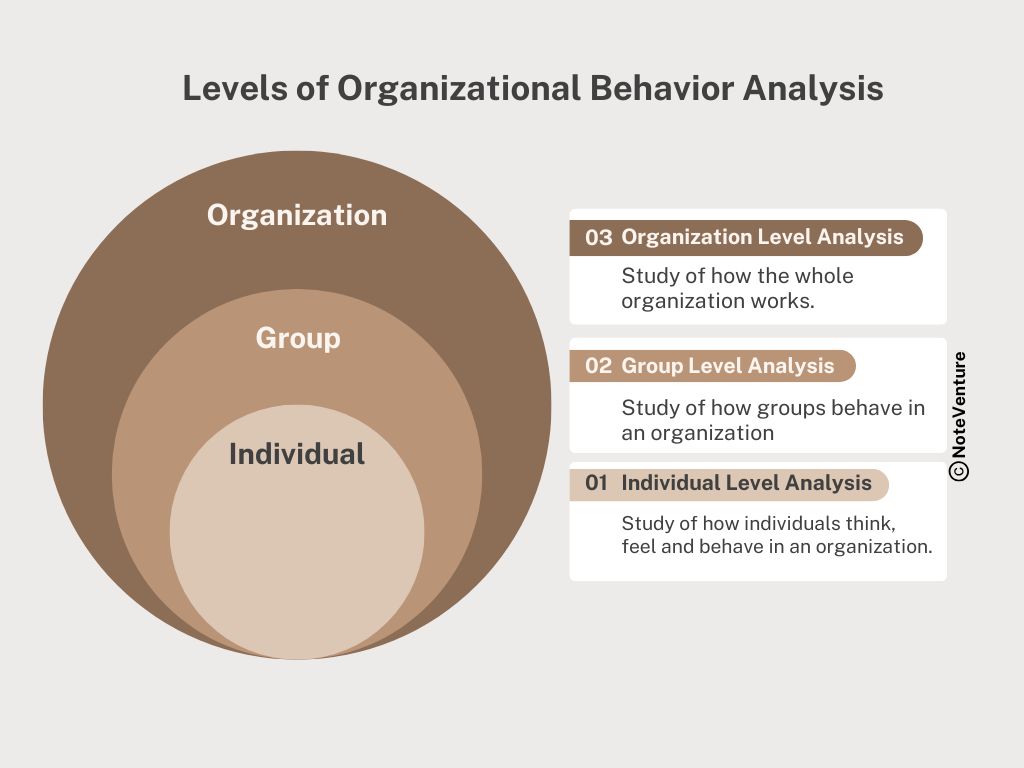1.1 Concept of Organizational Behavior (OB) | Levels of OB Analysis
… Hey there! Welcome to the first lesson of Unit 1. In this lesson, we will be covering Concept of Organizational Behavior (OB) & Levels of OB Analysis. As usual, I ask you to carefully study all these notes and think aloud or write down what you’ve learnt for effective memory. So, let’s get started.


हुन्छ Sir …..अब सुरु गरिहालौं!
Concept of Organizational Behavior (OB)
Definition of Organizational Behavior
Organizational behavior is the study of how people behave in an organization (एउटा organization मा मानिसहरु कसरी behave गर्छन् भन्ने कुराको study नै organizational behavior हो). This includes studying how people work together and how they communicate. It also looks at how people feel about their jobs and the company they work for. The goal of studying organizational behavior is to make the work environment better for everyone. By improving organizational behavior, companies can make their employees happy and more productive.
Features of Organizational Behavior
The features of organizational behavior are:

1. People – oriented: Organizational behavior is people – oriented because it focuses on people. It looks at how people work and also pays attention (ध्यान दिन्छ) to their needs and wants at the job. This creates a better workplace for the people.
2. Multidisciplinary approach: Organizational behavior is a multidisciplinary approach because it combines knowledge from different fields like sociology, psychology, etc, to understand human behavior in organizations.
3. Scientific Approach: Organizational behavior is a scientific approach because it applies scientific methods to understand human behavior in the workplace. It involves collecting data, analyzing it, and making decisions based on evidence.
4. Systematic study: Organizational behavior is a systemic study because it studies human behavior in organizations in a systematic manner by looking at individual, group, and organizational levels of analysis.
5. Goal-oriented: Organizational behavior is goal-oriented because it is concerned with how people behave in organizations to achieve their goals and organization’s goal.
6. Continuous Process: Organizational behavior is a continuous process because it is about learning, adapting, and changing continuously. It involves analyzing the past, understanding the present, and predicting the future to make better decisions.
Elements of Organizational Behavior
The elements or variables of organizational behavior are the factors that influence how organizations work. By understanding the key elements or variables that affect organizational behavior, organizations can make better decisions and improve their performance. Some of the key elements or variables of organizational behavior are explained below:
- People: People are the most important element of organizational behavior because they help the organization achieve its goals. Understanding how people behave helps to create a positive and productive work environment.
- Organizational Structure: Organizational structure is another important element because it helps to establish roles and responsibilities in the organization. A well-designed structure can improve communication and decision-making process in the organization.
- Technology: Technology is an increasingly important element of organizational behavior because today, more and more work is being done digitally. Understanding how technology impacts work can help organizations to be more efficient and effective.
- Environment: Environment is the element which refers to the external factors that impact the organization, such as the economy, laws and regulations, and competition. Understanding these factors is essential for organizations to survive in a changing environment.
Importance of Organizational Behavior
Organizational behavior is a field of study that focuses on how people behave in organizations. The benefits / significance / importance of OB are:
- Helps in better understanding of people: Organizational behavior is important because it helps in understanding the behaviors and attitudes of people in an organization. This understanding helps managers to interact with their employees more effectively.
- Helps in effective leadership: Organizational behavior is important because it provides a framework for effective leadership. Managers who have knowledge of OB can motivate, communicate, and influence their employees in a more effective manner.
- Helps in conflict resolution: Organizational behavior is important because it helps in solving conflicts in the organization. Conflicts can arise from differences in values, personalities, interests, or work methods. Knowledge of organizational behavior can help managers to identify and manage conflicts within the organization.
- Helps in better communication: Organizational behavior is important because it helps in better communication. Effective communication is essential for the success of an organization. Knowledge of organizational behavior can help managers to understand the communication styles of their employees, which can lead to improved communication.
- Helps in employee satisfaction and well-being: Organizational behavior is important because it focuses on the well-being of employees. Managers who have knowledge of organizational behavior can create a positive work environment. This leads to increased job satisfaction and employee retention (जागिरमा टिकिरहने अवस्था).
- Helps in adaptation to change: Organizational behavior is important because it helps organizations to adapt to change. Managers who have knowledge of OB can help their employees to handle change and make the necessary adjustments.
- Helps in achieving organizational goals: Organizational behavior is important because it helps organizations to achieve their goals. Managers who have knowledge of organizational behavior can find out the factors that can make the organization successful and then they can take steps to keep those factors present in the organization.
Levels of OB Analysis
Levels of Organizational Behavior Analysis
The levels of organizational behavior analysis are the different levels at which organizational behavior can be analyzed and studied.
Organizational behavior analysis has three levels: individual level, group level, and organizational level analysis.
- Individual Level Analysis: Individual level analysis is the study of how people (individuals) think, feel and behave in an organization. It includes understanding factors like motivation, perception, learning, and personality that affect how someone behaves. By understanding these factors, organizations can find ways to make employees happier and more productive in their jobs.
- Group Level Analysis: Group level analysis is the study of how groups behave in an organization. It includes understanding factors like communication, leadership, decision-making, and handling conflicts within groups. By studying group behavior, organizations can find out ways to improve teamwork and cooperation for better organizational performance.
- Organizational Level Analysis: Organizational level analysis is the study of the overall structure of the organization. It includes studying the organization’s structure, culture, and processes that affect the behavior of individuals and groups within the organization. By examining these aspects, organizations can find out ways to improve overall organizational performance.

माथिको ३ वटा points लाई एकपटक summary बनाएर पढम् है ! हेर्नुस् त अब कति सजिलै यी ३ वटै points, बुझिन्छ पनि सम्झिन्छ पनि |
- Individual level: This is the study of how individuals think, feel and behave in an organization. It looks at factors like motivation, personality, and learning.
- Group level: This is the study of how groups behave in an organization. It looks at factors like communication, leadership, and conflict resolution.
- Organizational level: This is the study of how the whole organization works. It looks at factors like structure, culture, and processes.
By understanding these different levels, organizations can improve employee satisfaction, productivity, and performance.
तपाईं अहिले TU Solution भन्ने tab मा हुनुहुन्छ
यहाँ तपाईंले यस chapter बाट अहिलेसम्म TU मा सोधिएका सबै question र त्यसको solution पाउनसक्नुहुन्छ। Question हरु chapter को topics अनुसार serially राखिएको छ।
Group A – Brief Answer Questions
Group A को लागि Chapterwise TU Solution
Concept of Organizational Behavior (OB)
Q) What is Organizational Behavior?
→ Organizational behavior is the study of how people behave in an organization. This includes studying how they work together and how they communicate. It also studies how people feel about their jobs and the company they work for.
Levels of Organizational Behavior (OB) Analysis
Q) What are the different levels of Organizational behavior analysis?
→ Organizational behavior analysis has three levels. They are:
1. Individual level analysis
2. Group level analysis
3. Organizational level analysis.
Group B – Descriptive Answer Questions
Group B को लागि Chapterwise TU Solution
Concept of Organizational Behavior (OB)
Q) What is organizational behavior? Explain the characteristics (features) of organizational behavior.
Definition of Organizational Behavior
Organizational behavior is the study of how people behave in an organization (एउटा organization मा मानिसहरु कसरी behave गर्छन् भन्ने कुराको study नै organizational behavior हो). This includes studying how people work together and how they communicate. It also looks at how people feel about their jobs and the company they work for. The goal of studying organizational behavior is to make the work environment better for everyone. By improving organizational behavior, companies can make their employees happy and more productive.
Features of Organizational Behavior
The features of organizational behavior are:

1. People – oriented: Organizational behavior is people – oriented because it focuses on people. It looks at how people work and also pays attention (ध्यान दिन्छ) to their needs and wants at the job. This creates a better workplace for the people.
2. Multidisciplinary approach: Organizational behavior is a multidisciplinary approach because it combines knowledge from different fields like sociology, psychology, etc, to understand human behavior in organizations.
3. Scientific Approach: Organizational behavior is a scientific approach because it applies scientific methods to understand human behavior in the workplace. It involves collecting data, analyzing it, and making decisions based on evidence.
4. Systematic study: Organizational behavior is a systemic study because it studies human behavior in organizations in a systematic manner by looking at individual, group, and organizational levels of analysis.
5. Goal-oriented: Organizational behavior is goal-oriented because it is concerned with how people behave in organizations to achieve their goals and organization’s goal.
6. Continuous Process: Organizational behavior is a continuous process because it is about learning, adapting, and changing continuously. It involves analyzing the past, understanding the present, and predicting the future to make better decisions.
Q) Explain the key elements/variables of organizational behavior.
Elements of Organizational Behavior
The elements or variables of organizational behavior are the factors that influence how organizations work. By understanding the key elements or variables that affect organizational behavior, organizations can make better decisions and improve their performance. Some of the key elements or variables of organizational behavior are explained below:
- People: People are the most important element of organizational behavior because they help the organization achieve its goals. Understanding how people behave helps to create a positive and productive work environment.
- Organizational Structure: Organizational structure is another important element because it helps to establish roles and responsibilities in the organization. A well-designed structure can improve communication and decision-making process in the organization.
- Technology: Technology is an increasingly important element of organizational behavior because today, more and more work is being done digitally. Understanding how technology impacts work can help organizations to be more efficient and effective.
- Environment: Environment is the element which refers to the external factors that impact the organization, such as the economy, laws and regulations, and competition. Understanding these factors is essential for organizations to survive in a changing environment.
Q) Explain the importance (significance) of organizational behavior.
Importance of Organizational Behavior
Organizational behavior is a field of study that focuses on how people behave in organizations. The benefits / significance / importance of OB are:
- Helps in better understanding of people: Organizational behavior is important because it helps in understanding the behaviors and attitudes of people in an organization. This understanding helps managers to interact with their employees more effectively.
- Helps in effective leadership: Organizational behavior is important because it provides a framework for effective leadership. Managers who have knowledge of OB can motivate, communicate, and influence their employees in a more effective manner.
- Helps in conflict resolution: Organizational behavior is important because it helps in solving conflicts in the organization. Conflicts can arise from differences in values, personalities, interests, or work methods. Knowledge of organizational behavior can help managers to identify and manage conflicts within the organization.
- Helps in better communication: Organizational behavior is important because it helps in better communication. Effective communication is essential for the success of an organization. Knowledge of organizational behavior can help managers to understand the communication styles of their employees, which can lead to improved communication.
- Helps in employee satisfaction and well-being: Organizational behavior is important because it focuses on the well-being of employees. Managers who have knowledge of organizational behavior can create a positive work environment. This leads to increased job satisfaction and employee retention (जागिरमा टिकिरहने अवस्था).
- Helps in adaptation to change: Organizational behavior is important because it helps organizations to adapt to change. Managers who have knowledge of OB can help their employees to handle change and make the necessary adjustments.
- Helps in achieving organizational goals: Organizational behavior is important because it helps organizations to achieve their goals. Managers who have knowledge of organizational behavior can find out the factors that can make the organization successful and then they can take steps to keep those factors present in the organization.
Levels of OB Analysis
Q) Explain the levels of organizational behavior analysis.
Levels of Organizational Behavior Analysis
The levels of organizational behavior analysis are the different levels at which organizational behavior can be analyzed and studied.
Organizational behavior analysis has three levels: individual level, group level, and organizational level analysis.
- Individual Level Analysis: Individual level analysis is the study of how people (individuals) think, feel and behave in an organization. It includes understanding factors like motivation, perception, learning, and personality that affect how someone behaves. By understanding these factors, organizations can find ways to make employees happier and more productive in their jobs.
- Group Level Analysis: Group level analysis is the study of how groups behave in an organization. It includes understanding factors like communication, leadership, decision-making, and handling conflicts within groups. By studying group behavior, organizations can find out ways to improve teamwork and cooperation for better organizational performance.
- Organizational Level Analysis: Organizational level analysis is the study of the overall structure of the organization. It includes studying the organization’s structure, culture, and processes that affect the behavior of individuals and groups within the organization. By examining these aspects, organizations can find out ways to improve overall organizational performance.
माथिको ३ वटा points लाई एकपटक summary बनाएर पढम् है ! हेर्नुस् त अब कति सजिलै यी ३ वटै points, बुझिन्छ पनि सम्झिन्छ पनि |
- Individual level: This is the study of how individuals think, feel and behave in an organization. It looks at factors like motivation, personality, and learning.
- Group level: This is the study of how groups behave in an organization. It looks at factors like communication, leadership, and conflict resolution.
- Organizational level: This is the study of how the whole organization works. It looks at factors like structure, culture, and processes.
By understanding these different levels, organizations can improve employee satisfaction, productivity, and performance.
Group C – Analytical Answer Questions
Group C को लागि Chapterwise TU Solution
